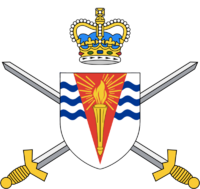Antarctic Circle States Army
| Antarctic Circle States Army | |
|---|---|
| Founded | 1 January 1905 |
| Country | |
| Type | Army |
| Size | 16,854 (Regular) 19,107 (Reserve) |
| Motto(s) | Pro Rege et Patria |
| Engagements | Second Boer War First World War Second World War Korean War Malayan Emergency Indonesian Confrontation Second Malayan Emergency Gulf War 1999 East Timorese crsis 2006 East Timorese crisis Regional Assistance Mission to Solomon Islands Iraq War 2014 Military Intervention in Iraq |
| Commanders | |
| Commander-in-chief | David C. Freeman |
| Minister of Defence | Kenneth Z. Miller |
| Chief of General Staff | Admiral James B. Campbell |
| Army Commanding General | Lieutenant General Douglas A. Wright |
| Army Deputy Commander | Major General Darragh L. Camden |
| Insignia | |
| Antarctican Army Flag | 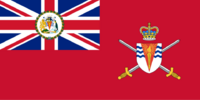 |
The A.C.S. Army is the principal land warfare force of Antarctic Circle States, a part of the Antarctic Circle States Armed Forces along with the Antarctic Circle States Navy, the Antarctic Circle States Air Force, and the Antarctic Circle States Polar Exploration Corps. The Army is commanded by the Army Commanding General (ACG), who is subordinate to the Minister of Defence, who commands the A.C.S. Armed Forces. The ACG also answers to the Chief of the General Staff (CGS)
Formed in 1905, as the Antarctic Auxiliary Forces, through the merging of several colonial militia forces of Antarctica. The Antarctican Army was initially made up of a few small units of professional soldiers, where the vast majority were in Territorial Defence Force (TDF) during peacetime. Following the outbreak of WWI, a standing regular army was formed in 1914 to send large numbers of soldiers to serve overseas.
During its history, the Antarctican Army has fought in a number of major wars, including the Second Boer War, the First and Second World Wars, Korean War, Malayan Emergency, Indonesia-Malaysia Confrontation, Gulf War, and more recently in Iraq. Although Antarctican soldiers have been involved in a number global conflicts, Antarctican territory has never come under direct attack. Since 1949, the Australian Army has also been involved in many peacekeeping operations, usually as part of the United Nations. Today, it participates in multilateral and unilateral military exercises and provides emergency disaster relief and humanitarian aid in response to domestic and international crises.
History
Formation
World War I

Interbellum
World War II
North Africa
Europe
Pacific
Cold War
Postwar
Counterinsurgency
and
Late Cold War
Recent History (1991-present)
Gulf War
Peacekeeping
War On Terror
Structure and Organisation
Army Headquarters is located in McMurdo, Erebus, and is responsible for providing forces at operational readiness for employment by the armed forces' operational commands. The command structure is hierarchical, with overall command residing with the Army Commanding General, who is immediately subordinate to Minister of Defence, the head of the Antarctica Armed Forces. Army Headquarters is further organised into nineteen corps, each commanded by a brigadier general. On the other hand, the deployable units are organised into brigades, which themselves consist of a complex mix of smaller units such as battalions. The A.C.S. Army currently fields two full-time 'regular' brigades, one part-time reserve brigade, and three part-time territorial brigades.
Regular Forces
Reserve Forces
Territorial Forces
Special Forces
The A.C.S. Army contributes one of the three special forces groups to the Antarctica Special Forces Command: the Antarctic Circle States Special Air Service (AQSAS). The AQSAS consists of one regular regiment and has its headquarters at TBD, TBD, TBD. It consists of 4 squadrons (A, B, C, and D) and a training wing. The regiment is supported by 223rd Garrison Squadron (22 Engineer Support Regiment) and C Company, 280th Intelligence Battalion (28 Intelligence Regiment), which are attached from Antarctica Engineers Corps and Antarctica Intelligence Corps, respectively.
| Primary Commands | |||
|---|---|---|---|
| Name | Current Commander | Headquarters | Responsibilities |
| Army High Comand | FM Herius Caesonius Melitus | Thessalona, Salonika | * Maintain Primary and Secondary commands * Provide the Federation with combat-ready forces capable of deployment to regional commands |
| Army Material Command | GEN Augustus Calventius Tremorinus | Armas, Lyressa | * Research and development of military materials * Maintain and distribute military materials * Maintenance of primary logistic chains |
| Army Personnel Command | GEN Liburnia Vera | Thessalona, Salonika | * Manage recruitment, training and in-service education of personnel * Assist Military Council with development of ground-based tactics and strategies * Act as administrative command to duty-unit financial aides |
| Secondary Commands | |||
| Army Medical Command | GEN Caelus Favonius Paenula | Thessalona, Salonika | * Development and distribution of medical knowledge and instruments * Establishment, maintenance, and operation of Army medical centres at home and abroad * Act as primary administrative command for primarily medical personnel (Doctors, dentists, etc) |
| Army Veterinary Command | LTG Kaeso Papirius Auxilius | Thessalona, Salonika | * Recruitment and training of military working animals * Selection and training of Animal handlers * Through-career care of animals * Housing and after-care of animals post-retirement |
| Army Aeronautical Command | LTG Julianus Suedius Elerius | RAD Agrinio, Eribia Minor | * Administrative manage in-service maintenance of fixed-wing and rotary aircraft * Research and develop new flying techniques and materials in partnership with suppliers and Material Command * Create and maintain new flying standards within the Army. * Act as primary liaison with the Federation Air Force. |
| Army Special Forces Command | GEN Georgius Lucioni | Koronia, Chrysopolia | * Manage selection and training of personnel into special forces * Administrate in-service special operations units on operations and at home * Manage special aviation units in partnership with Federation Air Force. |
| Combat Divisions | |||
| Name | Current Commander | Headquarters | Subunits |
| I Divisio Cataphractarius | MG Septimus Lucceius Tertius | Fort San Cristos, Lyressa | XII, V Legiones Catafractorius XVI Legio Pedites Loricatorum II Ala Tormentorum |
| II Divisio Mechanicum | BG Caius Baebius Marcellus | Fort Roger Westerly, Patrinos | III, XVII Legiones Catafractorius I, XXI Legiones Pedites Loricatorum IV Ala Tormentorum |
| XX Divisio Mechanicum | LTG Camillia Iusta | Fort Kozani, Stronkeia | X, XVIII Legiones Catafractorius XX Legio Pedites Loricatorum VI Ala Tormentorum |
| III Divisio Cataphractarius | MG Spurius Manilius Asina | Fort Agrippos, Peloponasia | IV, XIX Legiones Catafracotorius VII Legio Pedites Loricatorum I Ala Tormentorum |
| VII Divisio Pedites | LTG Potitus Canius Assanius | Fort Thesseus, Kalamos | II, IX, XV, XXII Legiones Pedites Loricatorum III Ala Tormentorum |
| LIV Divisio Aerium | MG Robertus Luzi | Fort Kankrattos, Aunogostos | VI, XIV, XXIII Legiones Pedites Aerium V Ala Tormentorum |
| IX Divisio Equitum | MG Lucius Domitius Seuso | Fort Lemnos, Megos Delphoria | VIII, XI, XXIV Legiones Pedites Equitum VII Ala Tormentorum |
| Reserve Divisions | |||
| XXXIV Divisio Equitum | BG Artemona Candidius | Fort Koureze, Eribia Minor | |
| LXI Divisio Pedites | STRA Philoxenus Quatruus (Acting) | Fort Iolcoezen, Agonon | |
| LI Divisio Aerium | BG Severus Lucretius | Fort Hellopeion, Kannis | |
| Active sub-units | |||
| IX Ala Discplina | COL Periphanes Calacicus | Reserve Station Alamyer, Pelopanasia | N/A |
| Divisio Reactio Rapidus | BG Jorg Grubbenheimmer | RAD Pottersfield Green, Samos | |
Personnel
Strength
Rank and insignia
Uniforms
Warrant Officers
| Pay Grade | OP1 | OP2 | OP3 | |
|---|---|---|---|---|
| Insignia | 
|

|

| |
| Title | Warrant Officer | Chief Warrant Officer |
Master Chief Warrant Officer | |
| Abbreviation | W-1 | W-2 | W-3 | |
Enlisted Personnel
Corporals and up are referred to as NCOs, or Non-Commissioned Officers. This is to distinguish the rank of Corporal from other ranked specialists who are at the same pay grade but do not have the same leadership responsibilities. A Corporal leads a section of two four-man fire teams, with a Lance Corporal acting as both the leader of the second fire team and as the second in command.
Training
Candidates for the Belfrasian Army undergo a common basic training scheme to bring all personnel up to a similar standard of basic military skills and understanding prior to further, specialised training being conducted. The specialised training itself is tailored by both the Belfrasian Military Training Command and the Regiment of which the individual has been assigned to upon finishing training. Training is divided over three phases, with the third phase being a loosely defined term in which soldiers in the Army are capable of gaining civilian qualifications or to further their skill-sets for wider opportunities when in the military.
The selection process for training are similar to that of other services in the Armed Forces. The process involves a number of suitability interviews, an aptitude test to identify potential specialisations, and a medical and fitness test. Potential Enlisted-level recruits have the opportunity to select a Regiment and a trade they wish to join, with later training orientated around this decision. Potential officer's, on the other hand, apply for sponsorship's from a regiment instead. When a regiment sponsors a potential officer, it guarantees a placement within it's organisational structure for that person once they finish candidacy training. However, the sponsorship only lasts three months over the training period to force the potential candidate to enter training as soon as possible.
Phase One training is similar regardless of desired specialisation or if the recruit intends to become an officer or an enlisted-level entrant. Phase One intends to bring all personnel up to a base competency for operations in the field, force protection, operational security, and general survivability including basic life saving training and marksmanship skills. This period of training lasts fourteen weeks, with a fifteenth week preparation for a 'Passing out Parade', in which the recruits formally finish Phase One and move onto Phase Two training following a two week rest period in which the recruits are able to mingle with family and friends. Despite this leave, recruits are still banned from leaving the country and are discharged if they are found to have broken this rule or have committed a criminal offense.
Following the conclusion of Phase One and the rest period, recruits are assigned to specialized training units around the country in order to qualify in their chosen specialities. It is at this point that the recruits are formally inducted into their chosen Regiments and have their trainings overseen by their commanding officers.
Equipment
Small Arms
| Model | Image | Origin | Type | Caliber | Details |
|---|---|---|---|---|---|
| Pistols | |||||
| Apion 10 | 
|
Semi-automatic pistol | 9×19mm NS | To be replaced by Apion 20 | |
| Muzaka Model 20 | 
|
Semi-automatic pistol | 11.43×23mm (.45 ACP) | Limited use | |
| Apion 20 | 
|
Semi-automatic pistol | 9×19mm NS | ||
| Submachine Guns | |||||
| NA-50 Submachine Gun | 
|
Submachine Gun | 4.6mm | ||
| NA-45 Submachine Gun | 
|
Submachine Gun | 9x19mm NS | Utilised by military police and special forces. | |
| Rifles/Carbines | |||||
| BR-55 Assault Rifle | 
|
Assault rifle | 5.56×45mm NS | Standard service rifle, older variants issued to Federal Guard. | |
| BR-55C Carbine Rifle | 
|
Carbine Rifle | 5.56×45mm NS | Standard service rifle. | |
| BR-70 | File:Scar L Standard.jpg | Assault rifle | 5.56×45mm 7.62×51mmNS |
In use with special forces | |
| BR-090 Assault Rifle | <imgur w=150>8CrJfxm.png</imgur> | Assault rifle family | 5.56×45mm/7.62×51mm NS | Replacing BR-055 as standard rifle of the Army. | |
| Shotguns | |||||
| Mossberg 500 | Pump-action shotgun | 12 Gauge/20 Gauge | |||
| Machine Guns | |||||
| NA-280 LMG | 
|
Light Machine Gun | 5.56×45mm NS | Can be felt-fed or utilised with STANAG magazines. | |
| NA-250 GPMG | 
|
General-purpose Machine Gun | 7.62×51mm NS | Belt-fed. | |
| NA-3 HMG | 
|
Heavy Machine Gun | 12.7mm NS | Mounted on vehicles or tripods | |
| DMRS and Sniper Rifles | |||||
| NA-620 SWS | Sniper Rifle | 7.62×51mm NS | Bolt-action | ||
| NA-720 AMSWS | Anti-materiel rifle | 12.7x99 | Bolt-action | ||
| NA-760 AMSWS | 
|
Sniper Rifle/Anti-Material Rifle | 14.5x114mm / 20x82mm / 20x110mm | Bolt-action | |
| NA-710 SWS | 
|
Designated Marksman Rifle | 7.62×51mm NS | Semi-Automatic | |
| Portable Anti-Material Weapons | |||||
| Crossbow | Unguided Anti-Tank Weapon | 67mm | Disposable one-shot weapon | ||
| AT48 Recoilless Rifle | File:At84 recoilless rifle.png | Unguided Anti-Tank Weapon | 84mm | ||
| MBT LAW | 
|
Disposable guided AT launcher | 150mm | ||
| Vanguard missile | 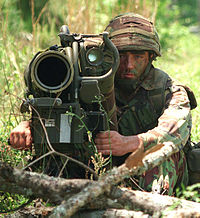
|
Anti-tank guided missile | |||
| Pike Missile | TBA | Guided munition | 40mm | Fired from grenade launchers and guided via designator | |
| Vesper missile | File:Vesper missile.png | Guided Anti-Tank Weapon | n/a | Fitted on vehicles and shoulder-launched. | |
| Explosives | |||||
| L109A1 | 
|
Fragmentation Grenade | n/a | ||
| ARGES mine | File:ARGES mine.png | Off-route Anti-Tank mine | n/a | ||
| L9 Bar Mine | Anti-Tank mine | n/a | |||
| L10 Ranger Anti-Personnel mine | 
|
Anti-personnel mine | n/a | ||
Artillery
| Model | Image | Origin | Type | Caliber | Details |
|---|---|---|---|---|---|
| Mortars | |||||
| Howitzers | |||||
| Rocket/Missile Artillery | |||||
| TDI Ares | 
|
Multiple rocket launcher system | X | Armored, self-propelled, multiple rocket launcher | |
| Raeda MARS | 
|
Wheeled advanced rocket system Vertical-launch missile system courier |
X | ||
| Theatre/Strategic Artillery | |||||
| ACM-7 Astaroth | Two-stage, Quasi-ballistic missile | X | |||
Wheeled vehicles
| Name | Image | Origin | Type/Variants | Number in Service | Details |
|---|---|---|---|---|---|
| BMI Jaguar | 
|
Utility Vehicle Family | x | In service as on-base/friendly territory utility vehicle only | |
| Pangolin MRAP | 
|
Mine Resistant Ambush Protected modular vehicle | x | ||
| Tamandua LTV | 
|
Light multi-role tactical vehicle | x | Slated to replace the Jaguar as deployment vehicle | |
| BMS Weasel | 
|
Armoured scout vehicle Tank Hunter Anti-Air Vehicle |
x | ||
| BMS Orestes | 
|
Armoured Personnel Carrier Infantry Fighting Vehicle Mobile Gun System |
x | ||
| Raeda MTV | 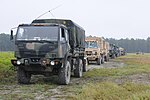
|
Medium multi-role tactical vehicle | x | ||
| Ferret FUTV | 
|
Ultra-light UtilityVehicle | x | ||
| Polecat PCV | 
|
Ultra-light Combat Vehicle | x | ||
| Rhinokeros MRAP | 
|
Mine Resistant Ambush Protected modular vehicle | x | ||
| Carrus HTMV | 
|
High-Threat Mobility Vehicle | x | 4x4 variants utilised by special forces only 6x6 variants in general usage | |
| Elephantus HTV | 
|
Heavy multi-role tactical vehicle | x |
Tracked vehicles
| Name | Image | Origin | Type/Variants | Number in Service | Details |
|---|---|---|---|---|---|
| Parmenio | 
|
Main Battle Tank Armored Recovery Vehicle Armored Engineering Vehicle Bridge Layer Assault Breacher |
x | ||
| Harma | 
|
Infantry Fighting Vehicle Light Tank Reconnaissance Vehicle Anti-Tank Vehicle |
x | ||
| Incitatus | 
|
Light tank | x | ||
| Testudo | 
|
Armoured personnel carrier Tank Destroyer Mortar Carrier |
x | Remaining variants to be replaced by new Harma models from 2018 onwards |
Water-craft
Aircraft
| Name | Image | Origin | Type/Variants | Number in Service | Details | |
|---|---|---|---|---|---|---|
| Helicopters | ||||||
| Clios Peregrine | 
|
Utility Helicopter Multi-Mission helicopter Electronic-Warfare Helicopter |
x | |||
| Aigios Stork | 
|
Troop/Cargo Assault Helicopter | x | Being phased out by Aigios Raptor | ||
| Clios Buzzard | 
|
Observation Helicopter Forward Air control Multi-Mission Helicopter Attack Helicopter |
x | |||
| Aigios Aquila | 
|
Attack Helicopter | x | |||
| Aigios Heron | 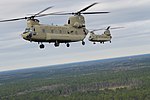
|
Transport Helicopter Multi-Mission Helicopter |
x | |||
| Aigios Raptor | 
|
V/STOL multi-mission aircraft | X | |||
| Unmanned Aerial Vehicles (UAVs) | ||||||
| OAT Needle | 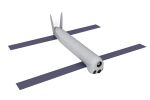
|
Light loitering munition | x | |||
| TI Szalinski | 
|
Hand-launched micro UAV | x | |||
| OAT Renattu | 
|
Hand-launched UAV | x | |||
| TI Oculus | 
|
Reconnaissance UAV | x | |||
| Clios Dragonfly | 
|
Hand-launched UAV | x | |||
Retired
- Bladed Weapons
- Pistols and revolvers
- Rifles, Carbines, and Muskets
- Submachine guns
- Machine guns
- Explosives and Launchers
- Ground vehicles
- Aircraft
- Watercraft
